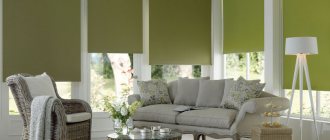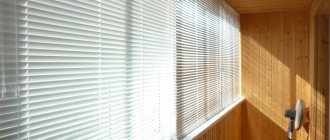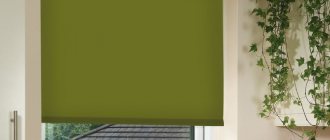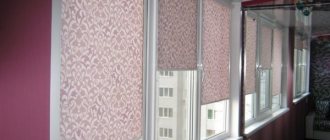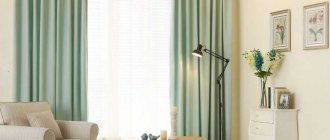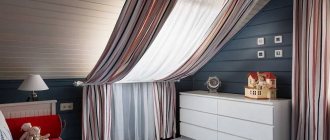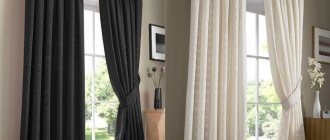At the final stage of the renovation, the next stage begins - decorating the interior in your own unique style. And here the choice of curtains plays a very important role, because often it depends on them how the room will visually look. Curtains add mood to the room and when you want to update the interior, you often start revitalizing the design by replacing the curtains.
It would seem that the choice has been made: the style and composition for the window have been selected, the necessary colors and materials have been found. But when making custom curtains, you can encounter many mistakes, which can only be corrected by purchasing new ones. How to get the curtains of your dreams without additional worries and costs? We'll tell you in our material.
How to choose the width of curtains
Usually, when ordering curtains, they are based on the width of the wall, which is not at all correct. As a result, the window has narrow curtains that do not cope with their direct function - protection from sunlight during the day and from lanterns and headlights at night.
To correctly calculate the width of the curtains, you need to measure the length of the curtain rod on which the curtains will be hung. Accordingly, the baguette is purchased and hung in advance, and not together with the curtain. In addition, you need to decide on the type of fastening. These can be eyelets, clips and loops that will become part of the decor, or braid and hidden fasteners that will be hidden from view and will not distract attention from the composition on the window.
There is such a thing as volume or curtain gathering factor - this is the ratio of the width of the curtain to the length of the curtain rod. The excess fabric is used to drape the curtains, without which the curtain will look like a sheet on a rope.
- The minimum coefficient is 1.5 if you do not need strong folds or the curtains serve only a decorative function.
- Factor 2 is the accepted standard for thick fabrics; this width of the curtain will provide beautiful waves or folds both closed and open.
- A coefficient of 2.5 or more is recommended by professional designers to create the most interesting ensemble on the windows. Moreover, this fullness of the curtain is accepted for dense, heavy materials; for light fabrics, the coefficient increases by 0.5 to maintain airiness.
Select the size of curtains according to the width of the window
As already mentioned, the width of the curtains is selected according to the length of the cornice and the required gathering factor, but there is no need to cover the entire wall with the window with the curtain, especially if their shades are similar. It’s not for nothing that when combining colors, designers advise choosing curtains with trim along the edges to separate them from the wall and highlight the windows. When looking at a window, you need to clearly understand where the wall ends and the curtain begins - this is how the room visually becomes wider.
The only place where full-wall curtains are applicable are panoramic windows or balconies. But even here you need to carefully select the width and make a reserve for draperies or choose the French version of roller blinds for decoration.
What curtains will go with gray wallpaper?
Decorating the walls in gray tones adds elegance to the room. The right combination with them helps to create a chic environment that evokes admiration. All shades of red, yellow and orange will go well with gray. They will enliven the interior and dilute the cold gray, adding warmth.
By choosing blue and green tones, you can visually enlarge the room. The white color of the curtains will bring lightness to it. The priority is soft tones of gray; they will add some sophistication to the design and make it unique.
How to calculate and choose the length of curtains
Here the choice is yours: how long you want the curtains to be. Usually choose from 4 options:
- short;
- to the windowsill;
- long;
- lying on the floor.
After determining the desired length, you can begin measuring. The basic rule is to start measuring not the height of the window, but the length of the wall from the cornice. Afterwards you can calculate the length of the fabric for the curtains.
When choosing curtains that will fall to the floor, add 20-30 cm to the resulting length. Designers advise you to think several times when choosing such curtains for an apartment. Of course, they look luxurious, especially in photographs, but they are least suitable for daily use. Most likely, they will become very dusty and very inconvenient to straighten them several times a day.
Long curtains are the most common window design option. They are elegant and multifunctional; it is very easy to complement your interior design with such curtains, because... there are a huge number of options. When calculating the length of the curtain, you need to subtract 3-5 cm from the resulting number to obtain a hygienic space. This way, the curtains will not look short, and cleaning will not cause unnecessary trouble.
If you like shortened curtains, there are 2 design options: a few centimeters above the window sill or 10-15 cm below. To calculate the length of the curtains, measure the length from the cornice to the window sill, and then subtract or add the necessary centimeters. Curtains above the window sill are most often used for the kitchen, and below - as so-called winter curtains. This window design protects from unnecessary light, but does not cover the radiator, which is important during the heating season.
Calculation example
When all the necessary measurements have been taken, it is time to calculate the width and length of the curtains or fabric for them. If the resulting width of the window area is 2 m and the length is 2.7 m, and you need to purchase curtains and drapes, then you can safely use the assembly factor (KS) = 2 and then we find that the width should be 4 m for a given length.
If you want the window to be decorated with original and unique curtains that are not available in the store, then you need to buy the required amount of fabric to sew them . So, how much fabric will be needed for curtains and drapes for our conditional window?
The standard width of a roll of translucent tulle is 2.8 m , which should be quite enough for the standard window height, so the length issue remains resolved. As for the width, given the width of the window and the selected frame, you will need 2 * 2 = 4 m of fabric. But since the allowances on the sides are 5 cm, the total amount of fabric will be 4.1 m.
The width of curtain fabric is usually 1.4, 2.8 or 3.0 meters. It’s good if the width of the canvas ideally matches the length of the window opening, but it may be that the width is not enough, and then you will have to measure the fabric lengthwise and use several canvases to cover the window opening. Here it is important not to forget about the combination of the pattern and the length of the repeat - a repeating element of the ornament. In this case, you can sew a special fabric together, or maybe just make curtains from two parts.
The calculation in this case will be like this:
amount of fabric = ((window opening height + allowance)*number of panels) + repeat * (number of panels – 1)
If the window width is 2 m and KS = 2, and the width of the fabric in the roll is 1.4 m, then to make curtains, for example, you will need 3 canvases: 1.4 * 3 = 4.2 m, with a repeat value of 0.35 m we get the following data:
amount of fabric = ((2.7+0.2)*3)+0.35*2=9.4 m
If after cutting the fabric and sewing the curtains there is a lot of fabric left , and this may be when a large pattern was chosen, then from the remnants it will be possible to sew tiebacks for curtains or small pillows for the sofa. When the curtains and other textiles in the room are made in the same style, this gives a special effect to the room.
It’s easy to sew the most common curtain models yourself, but if you doubt your professionalism or are planning to decorate a window with an elaborate model, then it is better to resort to the services of specialists.
Choosing the nature of the material for curtains
When choosing fabric for windows, it is important to decide on the function of the curtains: will they be just decoration or will they also perform their main function of protecting from the sun. In addition, the choice of fabric for curtains is influenced by the location of the room.
For a dark room with windows facing north, translucent tulle or light curtains made from natural fabrics will be enough to prevent twilight in the room. Additional blackout curtains can be excluded from the design, especially for a small room.
If the room is sunny and the light interferes during the day or at night street lighting comes into the windows, for the window it is worth considering a multi-level composition of translucent daytime curtains and thick dark fabric for the night. There are materials with a black-out effect that provide the best protection from the sun's rays. These curtains are great for a bedroom or children's room.
In addition, you can complement the selected ensemble with roller blinds and blinds, which will protect from bright light. The choice of colors, patterns and textures allows you to choose a curtain to suit every taste. The advantage of this solution is that they do not require additional fastenings and cornices; you can also choose an option with a black-out effect or the ability to adjust “day-night”. Roller blinds or blinds can act as independent window decoration, without the addition of textile curtains.
Decoration of narrow windows
Narrow openings are quite common in kitchens in panel houses. Such architectural decisions were also made during the construction of buildings at the beginning of the last century. Narrow openings look especially inorganic in spacious rooms with low ceilings.
You can solve this problem in the following ways:
- Install a cornice whose length is 2 times or more the width of the opening. You need to choose a product in a light color. Use curtains that cover part of the wall on both sides of the window opening. Drawings on the fabric should be in a horizontal orientation. These can be stripes, waves or zigzags.
Light color visually expands objects. This is the rule that should be followed when choosing material for curtains, tulle and drapes.
How to choose fabric for making curtains
It's no secret that poorly selected textiles can ruin the good impression of a stylish room. It is especially important to choose the material for curtains carefully, because the design of the window is the first thing that catches your eye when entering the room.
A good fabric should be wear-resistant, resistant to sunlight, and easy to care for. Increasingly, natural or mixed fabrics are being chosen for curtains in tribute to the fashion for eco-friendly interior styles. Jacquard, linen, cotton or satin are good choices for curtains. Such curtains can be thick or lighter; there are a huge number of options for patterns, ornaments, and shades. Velvet, velor or silk are suitable for living rooms, but these fabrics are difficult to care for and it is very easy to overload the interior with them. It is better to replace them with lighter fabrics with textile patterns or coating.
As for the color scheme and texture of the material, the main role here is played by the style of the interior and the shades of decoration of the room and furniture. You can choose contrasting colors, which will make the window the main accent in the room, or emphasize the overall style, and use other accessories for emphasis. Pastel and neutral colors suit any style of interior and furniture; curtains made of any fabric look great in these colors. Various patterns are very popular. Their choice is also great: geometry, flora and flowers, ethnics, even photo curtains. The main rules here will be compatibility and measure.
It is worth abandoning overly complex designs on windows with a large number of accessories. You can style simple curtains using original tiebacks and pins, or choose an interesting cornice. In general, curtains should visually increase the space of the room and add mobility and freedom to the room. Therefore, any ensembles that lower the ceilings or narrow the room must be abandoned in favor of a laconic design and simplicity of form.
